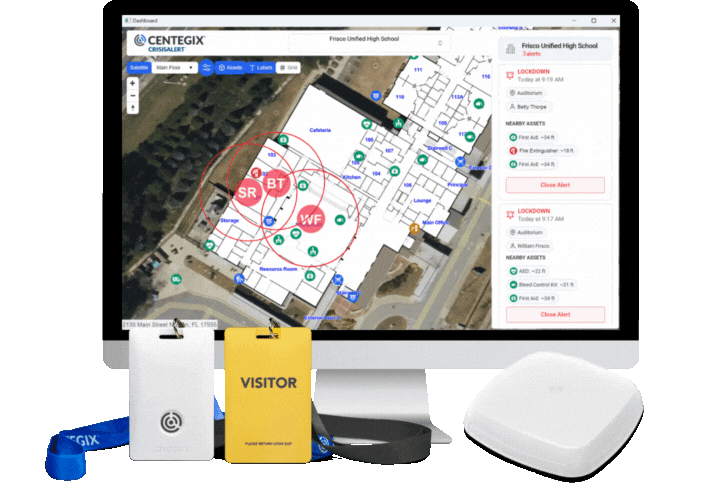Everyone deserves to feel safe at work. Unfortunately, workplace emergencies—from medical incidents to unauthorized visitors to violence in healthcare, educational, or municipal facilities—can’t be fully eliminated.
While emergencies vary in character and intensity, every event has one thing in common: preparedness is key. Keeping your organization safe requires preparation and collaboration among all stakeholders. To create a culture of safety, every community member must play a role in safety protocols and practices.
When team members work together, and safety leaders collaborate with first responders, your organization is better prepared to effect a positive outcome.
Current Best Practice: Create Safety Teams
A safety team prepares your organization to respond rapidly in a crisis. This team should encompass perspectives from multiple departments and levels throughout your organization, giving you a big-picture view of safety needs and concerns. This team works together to prepare and implement protocols for emergencies of all kinds, from medical situations to workplace violence in healthcare facilities, schools, or government buildings. Here are a few specific considerations and goals to keep in mind when forming safety teams:
Safety Teams in Schools
A school safety team collaborates to create, implement, and oversee the school’s safety plan. The team may comprise teachers, school administrators, safety directors, deans, counselors, custodians, and maintenance staff. This team works with first responders to establish emergency protocols and response plans. The team’s goal is to account and plan for all safety incidents, which helps to cultivate a safe environment where teachers can teach, and students can learn.
Safety Teams in Healthcare Facilities
Aggressive behavior and workplace violence in healthcare are ongoing concerns for healthcare organizations. The concern isn’t only with protecting the physical safety of patients and staff—it’s also about preserving their mental and emotional well-being. The ANA Nursing Resources Hub reports, “This under-reported epidemic has devastating results on the healthcare industry.”
Assembling a diverse safety team to coordinate with first responders is essential to promoting safety and preventing workplace violence in healthcare facilities. In this context, the safety team needs representation from various personnel, including administrative staff, nurses, doctors, custodial staff, security professionals, and others. Their varied experience and range of perspectives help prevent blind spots in safety planning and provide a more thorough awareness of patient and staff needs throughout the entire organization.
Safety Teams in Municipal & Government Buildings
As part of the current focus on improving safety in government buildings, Congress passed the Improving Federal Building Security Act of 2024. This bill requires Facility Security Committees to respond to security recommendations from the Federal Protective Service concerning facility security.
A facility security committee must include representatives of all federal tenants in nonmilitary facilities, the facility’s security organization, and the federal tenant. The committee addresses security issues specific to the facility and approves the implementation of security practices.
Use Technology to Facilitate Collaboration and Communication
Safety leaders must provide reliable, efficient safety solutions and adequate training so that all members of the organization can participate in creating a culture of safety. As part of your safety plan, technology can be a powerful ally in facilitating collaboration and communication among all members of your organization. Your emergency response solutions should be able to do the following:
- Empower staff members to indicate an emergency from anywhere on campus.
- Remain discreet and always available, not dependent on Wi-Fi or cellular, which can have coverage gaps.
- Send an immediate alert notification to onsite response teams and 911.
- Initiate visual and audio emergency notifications for the entire campus when appropriate.
- Provide a map showing responders who needs help and their precise location—including the room and floor.
- Provide responders with the location of safety assets on campus, including AEDs, fire alarms, extinguishers, and evacuation points.
- Reduce human error and delays by automating emergency notifications and eliminating manual hand-off steps.
Technology with these capabilities can help empower your entire community to respond effectively and rapidly to incidents ranging from medical emergencies to workplace violence in healthcare, schools, municipal, or government facilities.
Safer Institutions Mean Safer Communities
Abraham Maslow’s Hierarchy of Needs details five needs that must be met for a person to fully thrive. At the most basic level, we need food, shelter, and protection from danger; when those core needs remain unmet, we cannot progress up the pyramid to experience the love, relationships, and personal growth that lead to fulfillment and self-actualization.
Dr. Duncan Borg Ellul, Head of Business School and Lecturer at MLI, notes that Maslow’s five needs correspond closely with the five pillars of society: economy, education, healthcare, the justice system, and culture/the arts. When we create safe environments within the facilities our community depends on, we provide the foundation for a healthy society. A safe environment is key in institutions like these:
- Schools, colleges, and universities
- Government and municipal buildings
- Healthcare facilities
By proactively addressing safety concerns in these places, we aren’t just protecting lives; we’re promoting a sense of well-being for the entire community. By working together to promote safety, we create an environment where everyone can thrive.
Use Technology that Empowers Community Members
The right safety technology enables everyone to understand and participate in safety protocols.
Technology should prioritize collaboration between first responders and safety leaders and should empower every person to request help when needed. The right technology minimizes delays because time is the most critical factor in incident response.
Workplace violence in healthcare facilities, schools, and government buildings is an unfortunate reality for which every institution must prepare. Of course, emergencies aren’t limited to extreme situations threatening the entire campus. An institution dedicated to creating a safe environment for all members will implement protocols and technology to handle emergencies of all types. Your dedication to preparedness empowers your community, reduces response time, and saves lives.
Creating a Safety Ecosystem
The CENTEGIX Safety Platform™ is designed to empower staff, teachers, healthcare professionals, and government employees to communicate directly with first responders in an emergency. The Safety Platform runs on private LoRaWAN and Bluetooth networks and facilitates rapid response to emergencies by:
- Giving first responders access to up-to-the-minute location data with Safety Blueprint™: Responders know precisely who needs help—and where.
- Allowing wearers of CrisisAlert mobile duress buttons to participate in creating a safety ecosystem: Wearers can push a button, and help comes.
- Reducing incident response time: Responders know the precise location of an incident and where to find safety devices.
“I love the simplicity of the CENTEGIX safety solution. I love the fact that it empowers everyone to be on duty. We have a saying on our team that we’re all on duty when it comes to safety. This actually lives that message out.” – Mark Martin, Superintendent, Meade County School District, Kentucky.
Learn more about how CENTEGIX can help your organization create a culture of safety for everyone.












